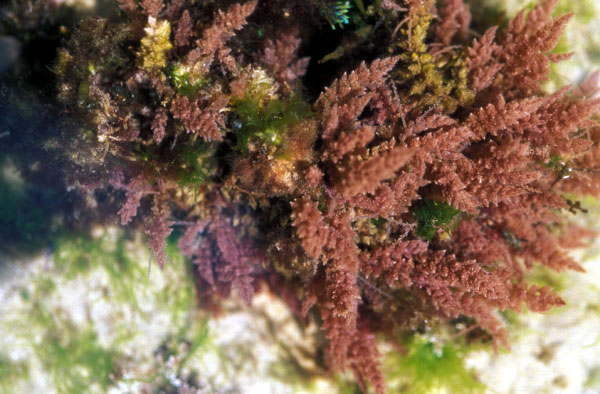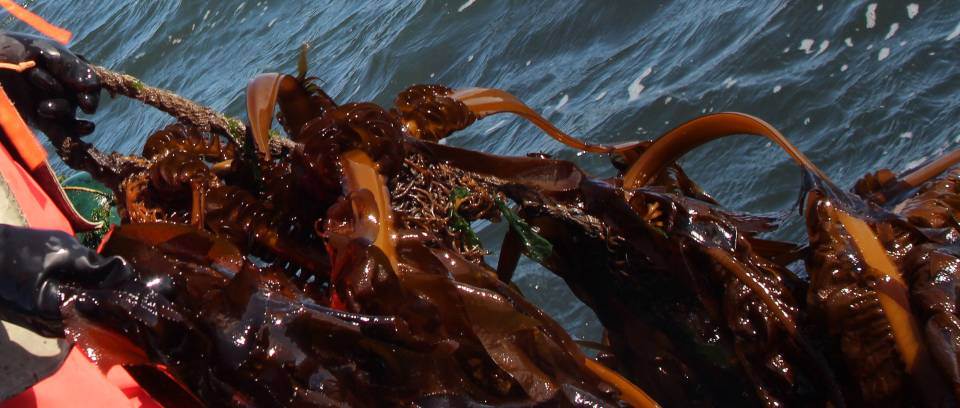Farming Seaweed in Kiribati: A practical guide for seaweed farmers
Digital library
-
-
Aquaculture products serve two broad market categories, namely, ‘niche’ markets and ‘mass’ markets. There are hundreds of different species produced in aquaculture, most of them niche-market species, that is, those produced in modest volumes and sold at relatively high prices to a limited number of people. Examples include various species of eels, flatfish, bass, grouper, snappers and bream. In general, at present costs of production, these species will not meet mass market value expectations and are not likely to be candidates for future, large-scale aquaculture expansion. In contrast, there are very few species that are produced on a scale large enough and at a cost low enough to be considered mass market items. Examples include some shellfish, carp, tilapia, catfish, and salmon.
-
This study explores the potential cultivation of the giant kelp Macrocystis pyrifera (L.) C.A. Agardh in southern Chile, for the development of novel food products. The study demonstrates the importance of considering the collection site of the parent sporophytes for successful cultivation. This study also shows that the ropes must be seeded with 10,000 to 40,000 spores ml−1, depending on the culture method used. We also demonstrated that under environmental conditions in southern Chile, the seeded ropes must be put at sea at the latest during autumn (April) in order to reach the harvesting season in December. However, several other management aspects must be considered to improve the quality of the product. Our final estimation indicates that over 14.4 kg m−1 of rope (fresh weight) can be produced and from this total production, over 70% can reach the quality to produce different food products that are already being introduced in oriental countries. The remaining 30% can be used for abalone feeding and is also available for the organic fertilizer industry located in Chile.
-
Offshore fish farms are highly capital intensive, and operational expenditures are inherently greater than for conventional inshore cage culture systems. Research and development costs offshore
are exorbitant, and the risks to investment are very real, and uninsurable. To attract investment, recapture these higher costs, and return an appropriate profit, open ocean ventures must look to a willingness on the part of the consumer to pay a premium for open ocean grown products. -
Many aquaculture industries generate a nutrient-rich waste stream that can lead to eutrophication of coastal waters. To address this environmental issue, the bioremediation potential of several native Northeast American species of Porphyra was assessed and compared to the well-known Asian species. Porphyra thalli were cultured over 4 weeks at 15 °C at a stocking density of 0.4 g FW L �1 . At 3- to 4-day intervals nutrient uptake, tissue N accumulation and phycobiliprotein concentration (PBP) were determined as functions of nitrogen (N) concentration (25–300 μM) and N source (nitrate vs. ammonium). Growth rates were measured weekly. Growth and tissue N reached maximal levels at inorganic N concentrations of 150–300 μM. Maximum growth rates ranged from 10% to 25% day �1 , although induction of archeospores reduced average growth rates in many cases. No evidence of ammonium toxicity (reductions in growth rate) was observed; in fact, similar values were found with both N sources. Ammonium generally yielded higher PBP and tissue N contents than nitrate. Porphyra amplissima presented the highest growth rate, followed by the Asian Porphyra yezoensis. Under the experimental conditions, Porphyra spp. removed 70–100% of N within 3–4 days at N concentrations up to 150 μM, but was less efficient in removing inorganic phosphorus (35–91% removal). The highest tissue N and PBP concentrations were found at 150–300 μM of N, with N values close to 7% DW. Overall, Porphyra appears to be an excellent choice for bioremediation of moderately eutrophic effluents, with the added benefit that tissue may be harvested for sale.
-
Kelpak®is a seaweed extractfromthe phaeophyte,Eckloniamaxima,used to enhance growthand production of terrestrial plants. It is also beneficial for some red and green seaweeds. Assuch, we assessed if Kelpak® could enhance growth and thermal tolerance of the brownseaweeds,Saccharina latissimaandS. angustissima. Juvenile sporophytes were dipped (30 or 60min) in Kelpak®solutions of different concentrations (0.001, 0.005, 0.05, 1 and 5ml L-1). Thesesporophytes were then cultivated in half-strength PES at different temperatures (12, 16, 19, 23and 25°C±1) for 20 days. The surviving sporophytes were then moved to 18 ± 1°C and cultivatedfor 14 additional days. Results show that temperature was the main factor driving survival andgrowth. Both species exposed to the temperatures of 23and 25°Cdied during the first seven days.Furthermore, no significant differences were observed in growth of sporophytes at thetemperatures of 12 and 16°C. Results also show that treated sporophytes exposed to 18°C, thesublethal temperature, particularlyofS. angustissimashowed a higher survival and overall vigorthan non-treated sporophytes. These results indicate that Kelpak®may enhance thermal toleranceand growth ofS. latissimaandS. angustissimaexposed to sublethal temperatures.
-
Experimental culture of Gracilaria was done in the Kovalam Backwaters at the Mariculture Centre, Muttukadu, Tamil Nadu. The study, conducted over two years, revealed that the period June to March was condusive to growth. The rate of growth was better in the open, unenclosed area than in ponds. Growth was best during the period June to September. The potential yield in the different growing seasons has been estimated for the open area as well as ponds. The relation between the growth of seaweeds and some environmental conditions in the farm is discussed. A strategy is suggested for the continuous culture and domestication of this species in the area.
-
In the US, seaweed aquaculture is still a developing industry. Since a significant number of seaweed farms are located in urbanized estuaries, cultured seaweeds could accumulate contaminants such as heavy metals. A warm temperate red algal species, Gracilaria tikvahiae and a cold-water brown algal species, Saccharina latissima were cultivated at three sites in Long Island Sound (LIS) and New York (NY) estuaries to biomonitor potentially toxic metals. Metal concentrations were below almost all national and international regulatory limits for human consumption. For example, the highest measured concentrations of Hg in tissue samples of G. tikvahiae and S. latissima are 88–93% less than the limit set by the Food and Drug Administration of the USA. Concentration maxima of Cd in G. tikvahiae and S. latissima were 20% and 32%, respectively, lower than stringent French limits. Maximum levels of Pb in tissue samples of G. tikvahiae (but not S. latissima) were close to the French limits at the NY estuary site. These results indicate generally that heavy metal contents of seaweeds cultivated urbanized estuaries should be monitored since accumulation appears to be site-dependent. The great capacity for the accumulation of nitrogen and other nutrients in seaweed tissues, improving water quality, is also accompanied by the uptake of other, less desirable materials.
-
Rates of inorganic nitrogen uptake by three Northeast US and three Asian species of Porphyra were compared in short-term incubations to evaluate potential for longer term and larger scale examination of bioremediation of nutrient-loaded effluents from finfish aquaculture facilities. The effects of nitrogen (N) species and concentration, temperature, acclimation history, and irradiance were investigated. Uptake rates increased ca. nine-fold from 20 to 150 μM N. Nitrate and ammonium uptake occurred at similar rates. Irradiance had a strong effect, with uptake at 40 μmol photons m−2 s−1only 55% of uptake at 150 μmol photons m−2 s−1. N-replete tissue took up inorganic nitrogen at rates that averaged only 60% of nutrient-deprived tissue. Although there were species (P. amplissima > (P. purpurea = P. umbilicalis)) and temperature effects (10 C>5 C>15 C), interactions among factors indicated that individual species be considered separately. Overall, P. amplissima was the best Northeast US candidate. It took up ammonium at faster rates than other local species at 10 and 15 C, two temperatures that fall within the expected range of industrial conditions for finfish operations.
-
Although Korea is third in seaweed production and second in shellfish production globally, this is the first study evaluating ecosystem services of seaweed and shellfish aquaculture in Korea. The objective of this study is to evaluate nutrient bioextraction capacities of major seaweed and shellfish species aquacultured in Korea. C (C) removal of three major aquacultured seaweed species, Neopyropia yezoensis, Saccharina japonica, and Undaria pinnatifida were 24,247, 8,423, and 12,758 tons, respectively, in 2016. N (N) removal of these species was 4,088, 732, and 1,244 tons, respectively. The C and N removal of the Pacific oysters (Crassostrea gigas) were 14,693 and 1,050 tons, respectively. Manila clams (Venerupis philippinarum) removed 2,120 tons of C and 136.5 tons of N. Together, 161,846 tons of CO2 and 7,251 tons of N were removed by three major seaweed species and two shellfish species. These values are significant amounts, equivalent to 5.7% of CO2 and 8.6% of N discharged from all wastewater treatment plants in Korea. These results suggest that nutrient bioextraction by aquacultured seaweed and shellfish can be a cost efficient, affordable, and equitable solution for coastal nutrient management programs in Korea and elsewhere.





